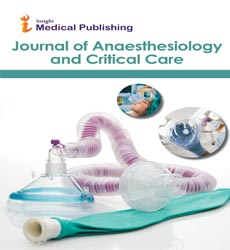Anticipating ARDS and Resulting in Septic Patients
Ghafur Arshad*
Department of Anaesthesiology, University Hospital Basel, Basel, Switzerland
- *Corresponding Author:
- Ghafur Arshad
Department of Anaesthesiology, University Hospital Basel, Basel, Switzerland
E-mail: aghafur@gmail.com
Received Date: November 23, 2021; Accepted Date: December 07, 2021; Published Date:December 14, 2021
Citation: Arshad G (2021) Anticipating ARDS and Resulting in Septic Patients. J Anaesthesiol Crit Car. Vol.4 No.3:13
Sepsis is defined as organ dysfunction caused by an unbalanced host response to infection. A common cause of acute respiratory distress syndrome is sepsis (ARDS). Both syndromes have a high mortality rate. Sepsis and ARDS are highly heterogeneous, making diagnosis and mortality estimation difficult.
Having an easy-to-measure biomarker (BM) or a panel of BMs at the bedside would be extremely helpful in identifying patients at risk for ARDS or with a high likelihood of death. The use of BMs to implement an understanding of how ARDS or sepsis evolve through the application of agonists or antagonists of specific BMs would have an impact on personalised treatment for increasing survival in sepsis and ARDS. Although there are currently no therapies available that, given early knowledge of serum/plasma levels of any BM, would prevent or mitigate the development of ARDS or its associated mortality, there is hope that early stratification of patients based on the levels of selected BMs at the time of sepsis/ARDS onset, or within the first 24 h, could represent a novel strategy for early stratification of sepsis/ ARDS into prognostic categories and patient selection.
Protein BM candidates are chosen based on their biological roles in the disease process. Endothelial and epithelial injury, inflammation, coagulation, fibrosis, and apoptosis markers have all been studied in the case of ARDS. A meta-analysis was performed by the scientists, who provided a ranking of individual BMs associated with ARDS diagnosis and outcome. Another group has published a number of reports on BM panels, either alone or in combination with clinical variables. They reported a panel of 7 BMs with enhanced ability to distinguish between patients with and without acute lung injury in critically ill patients with traumatic injuries, as well as a panel of 5 BMs capable of predicting ARDS in patients with severe sepsis. They also discovered that combining BMs and clinical predictors improved the prediction of ARDS outcome. They have recently validated a model that combines two BMs and a clinical variable to predict hospital mortality in ARDS patients.
The researchers wanted to find a small panel of biological and clinical markers that could be used to identify septic patients who were at risk of developing ARDS and had a higher chance of dying. They hoped that these panels would aid in the optimization of personalised treatment in sepsis and ARDS. They measured serum levels of BMs identifiers of diverse pathophysiological changes during the progression of the disease in septic patients with and without ARDS: receptor for advanced glycation end-products (RAGE) and surfactant protein (SP)-D as indicators of alveolar epithelium damage; angiopoietin (Ang)-2 and intercellular adhesion molecule (ICAM)-1 as markers of vascular endothelium damage; inter We also measured the proteins amphiregulin (AREG) and chemokine (C-X-C motif) ligand 16 based on previous research (CXCL16).
In conclusion, the study confirms the importance of RAGE and Ang-2 and supports the novel inclusion of CXCL16, along with the clinical marker PaO2/FiO2, in the development of a panel for ARDS prediction in septic patients. It also confirms the relevance of several previously associated BMs, such as IL-1RA, SP-D, and Ang-2, for panels predicting mortality or cumulative survival in septic patients, with APACHE II and SOFA scores serving as the clinical variables of interest, while demonstrating the utility of including CXCL16 in the panel. The composition of the panels for predicting mortality and cumulative survival varies depending on the subgroups of septic patients. More research is needed to validate the use of these panels in plasma samples.
Open Access Journals
- Aquaculture & Veterinary Science
- Chemistry & Chemical Sciences
- Clinical Sciences
- Engineering
- General Science
- Genetics & Molecular Biology
- Health Care & Nursing
- Immunology & Microbiology
- Materials Science
- Mathematics & Physics
- Medical Sciences
- Neurology & Psychiatry
- Oncology & Cancer Science
- Pharmaceutical Sciences
